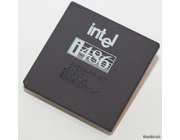Intel i486 DX33
Being made in the 15th week of 1991, this is an early 486DX33. In that time-frame the 386 at 25MHz or 33MHz was considered a modern PC. 286 was already low-end and the 486 was high-end. Note that the 486 logo is missing the DX suffix because there was no 486SX made yet. The first SX CPUs started appearing in Q3 1991.
In early 1991 this CPU would provide plenty of processing power for most people, despite that technology was improving very fast. Just one year later, 1992, the 486DX2 would arrive and a 486DX2/66 really is twice as fast as this DX33. Nice systems to have back then but unfortunately Vesa Local Bus (VLB) wasn't available yet so you'll be stuck with the much slower ISA-bus. In graphics-hungry applications and games the VLB-bus really makes the difference on a 486.
The 486DX has an integrated floating point unit (FPU) which speeds up applications like CAD or spreadsheets tremendously. In most main-stream applications and games that run fine on a 486, the FPU doesn't really come into play. Running Doom or Windows 3.1 with or without FPU doesn't make a practical difference. 486's with the SX-designation don't have the FPU enabled.
In the 386-line the DX and SX have different meanings, however. DX means that the CPU runs with a 32-bit external bus and SX with 16-bit. Both CPU's are internally 32-bit and none of them feature a FPU. In most cases you can install a separate FPU in a special socket.
 NG80386SX -20
NG80386SX -20
